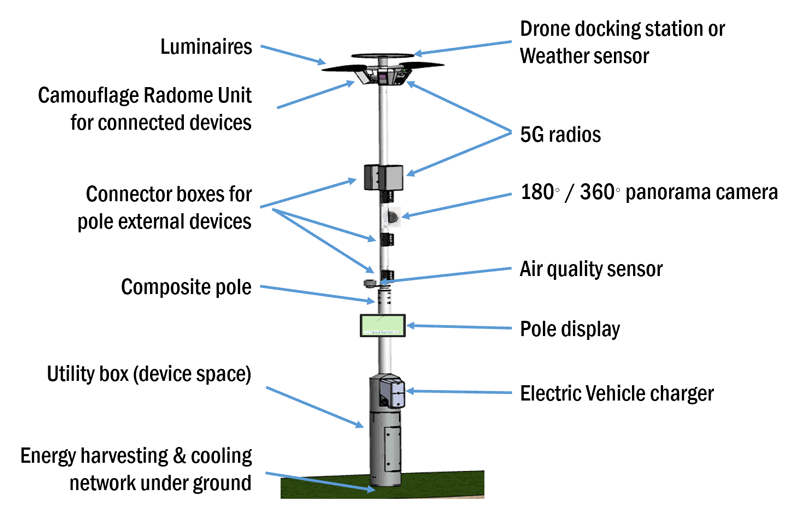by Jussi Varis (VTT)
LuxTurrim5G is developing and demonstrating a fast 5G network based on smart light poles with integrated antennas, base stations, sensors, screens, and other devices. This joint project with research institutes and companies opens new digital services and business opportunities for a real smart city.
Our societies and cities are faced with the challenges of improving security, energy efficiency, effectiveness of transportation and quality of living. There is a growing need for a new generation service infrastructure that provides a digital ecosystem in smart cities and enables the development of smart city infrastructure and services, thereby opening novel service and business opportunities for companies and new micro-operators.
Current mobile networks will soon be insufficient to serve the increasing number of users of bandwidth-intensive digital services. This bottleneck threatens the realisation of important smart city digital services, which will require an effective and reliable telecommunications network for connection and distribution. This problem can only be solved with the use of small cell radio technology and higher frequencies. It is also of utmost importance that the networks work well indoors, a salient problem with modern energy-efficient buildings. The propagation conditions are particularly challenging at frequencies above 6 GHz, which will play a significant role in 5G networks.
LuxTurrim5G’s Approach
The LuxTurrim5G project is formed by a consortium of selected forerunner companies (Nokia, Teleste, Vaisala, Sitowise, Indagon, Lammin Windows and Doors, Premix, Ensto, and Rumble Tools) and research organisations (VTT, Aalto University, and Tampere University). The project has been investigating the technological opportunities and economic feasibility of the digital ecosystem, by developing proof-of-concept prototypes and demonstrating concrete technical solutions for the smart light pole-based 5G infrastructure. The project will make big data capacity available and provide an open access platform for new digital services – both for technology and business.
One of our goals is to integrate the high capacity and low latency 5G radio technology and other equipment to a novel composite light pole, which acts as a mechanical structure for the antennas. The antennas will be designed in such a way as to be invisible and guarantee transparent signal propagation through the radome [1]. Miniaturised antenna solutions, small cells, and the novel smart lamp post infrastructure form a disruptive concept, which could enable online digital services for a smart city. The high integration level connected with thermal management challenges [2] requires robust structures and the highly-automated network installation and management is a challenge that is yet to be solved.
LuxTurrim5G small cell technology will also enable accurate positioning and navigation services in challenging environments. Modern buildings fit this description; the coverage from the 5G lamp posts must reach indoors by penetrating new selective window glass. The project has been verifying the technology’s effectiveness in this regard through radio propagation measurement campaigns with the aid of drones, automated cars, and robots.

Figure 1: LuxTurrim5G light pole with integrated 5G mmW base station and a set of sensors and cameras.
The solutions, based on 5G small cells integrated to smart light poles together with selected sensors and related services, have been demonstrated in field trials. Currently, Nokia campus in Espoo has a test network of four smart poles in operation. The poles carry millimetre wave radios, air quality sensors, cameras, displays, etc. (see schematic in Figure 1) supported by a service platform with edge computing capabilities. Service prototypes developed for testing the platform enable early market opportunities for participating companies. Examples of the services implemented in the project include sensor device monitoring and management, video analytics (person anonymisation and pose estimation in video feeds from surveillance cameras), climate and air quality analysis and visualisation, seamless positioning for machines and humans, info sharing (active screens aware of human presence), and smart lighting control. Of course, many other services and their combinations can be built on top of the platform, for instance, control of autonomous vehicles to enable effective and sustainable modern urban transport.
Searching for Business Opportunities
Although the project focuses on technical innovations, business opportunities are the key underlying driver for the innovations [3]. The business environment in the digital smart city ecosystem is complex, with a range of public and private stakeholders. Companies need to identify their role in the business context and in the LuxTurrim5G platform ecosystem. Ultimately, the main concern is, how do individual companies create value to the ecosystem and make a successful business case? From a scientific perspective the question is twofold: how to understand the individual technology value proposition and its relation to other technologies in the platform, and what kind of business model is viable when competing in global markets.
References:
[1] P. Peltonen, et al.: “Large-Eddy Simulation of local heat transfer in plate and pin fin heat exchangers confined in a pipe flow,” international Journal of Heat and Mass Transfer, 134, 2019.
[2] J. Järveläinen, et al.: “Characterization of mmWave radomes for base stations and automotive radars”, in Proc. 13th Eur. Conf. Antennas Propag., 2019.
[3] J. Hemilä: “Start-up opportunities in future 5G connected Smart Cities”, in Proc. ISPIM Connects Fukuoka – Building on Innovation Tradition, on 2nd - 5th December 2018.
Please contact:
Jussi Varis
VTT Technical Research Centre of Finland











